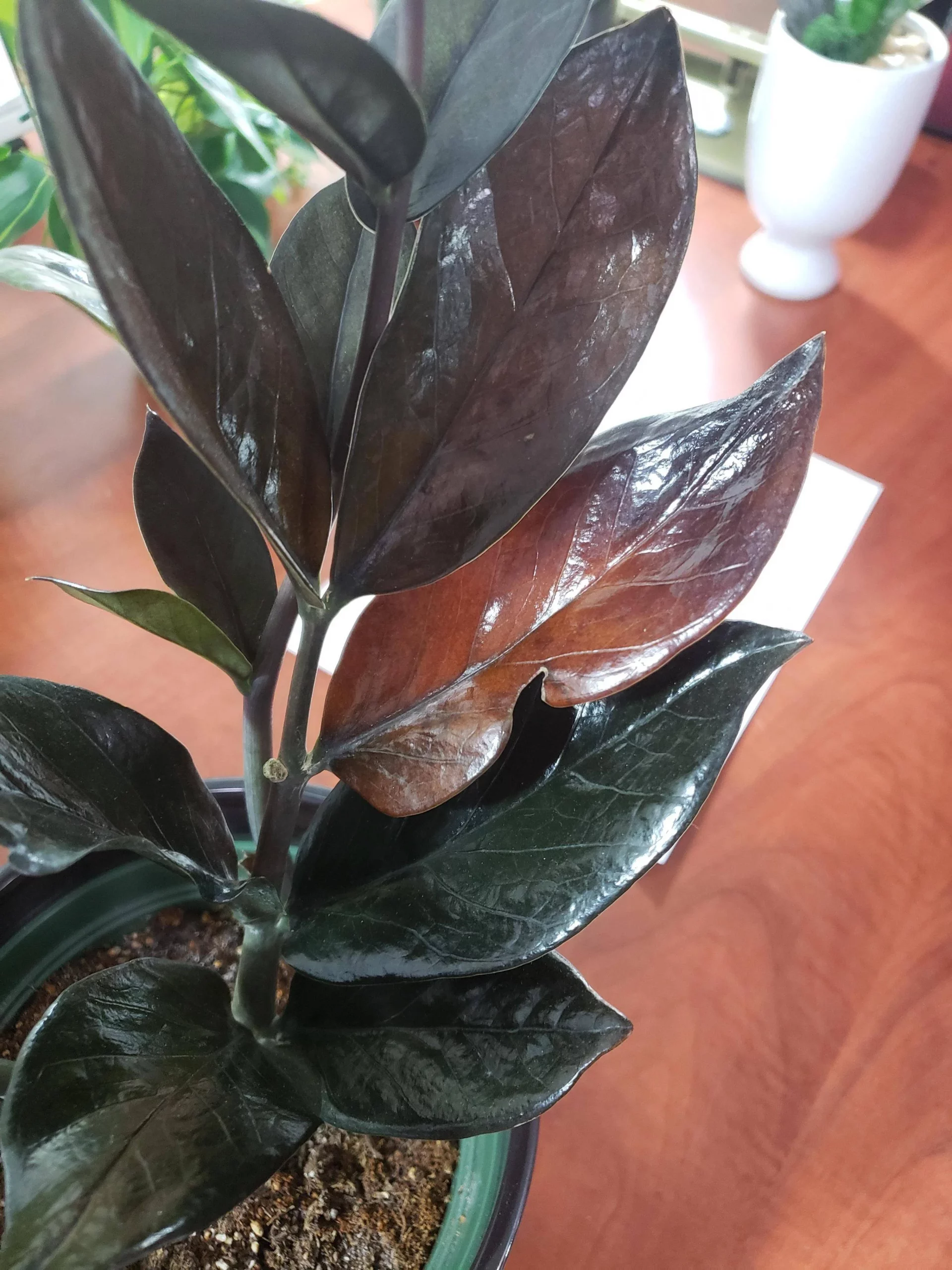ZZ plants (Zamioculcas zamiifolia) are the hardest and symbolic houseplants that can thrive in any condition. But this does not make them invincible to common leaf problems. If notice your ZZ plant leaves turning brown, do not panic.
ZZ plant leaves turning yellow and brown are the leading leaf problems that affect beautiful houseplants. I wrote this article to share some of the common causes and their respective solutions or fixing tips. Take the time to read through until the end.
10 Causes of ZZ Plant Leaves Turning Brown
Browning leaves on ZZ plant can be alarming among novice houseplant enthusiasts. But identifying the exact cause will help implement the right action and fix it. Below are the common causes of brown leaves on ZZ plants:
Natural Aging Issue
Aging is the possible cause of brown leaves on your ZZ plant. As your houseplant matures, the lower leaves deteriorate and turn yellow then brown. Natural aging issue is inevitable since it is part of the houseplant life cycle.
We recommend using a sterilized pair of scissors to remove the brown and yellow leaves from your indoor plant. The routine will help to maintain healthy growth and beautiful appearance. Besides that, it will help redirect energy and nutrients to growing regions.
Be sure to trim the aging leaves during the spring. It is the season where most plants experience fast growth. Remember to provide proper care to support healthy growth. You can also hire professionals to help remove the yellow and brown leaves.
Overwatering Problem
Overwatering is the leading cause of ZZ plant leaves turning brown. It occurs due to root rot that inhibits the plant from absorbing water and nutrients. A waterlogged environment prevents the roots from accessing adequate oxygen leading to root rot.
ZZ plant brown spots on leaves are due to nutrient deficiencies and poor overall health. Always inspect the soil moisture before watering your indoor ZZ plant. We recommend inserting the finger in 2-3 inches of top soil, if it feels dry then water your plant.
Ensure that the pot has proper drainage to prevent water from pooling at the bottom. If root rot is suspected, carefully remove the plant from its pot and inspect the roots. Trim any mushy or discolored roots and repot the ZZ plant in fresh, well-draining soil.
Inconsistent Watering Habits
Underwatering is another leading cause of brown leaves on ZZ plants. Many houseplants use soil moisture to dissolve and transport nutrients to various parts of the plant. Inadequate soil moisture will inhibit nutrients transportation leading to brown leaves.
Besides that alternating periods of drought and excessive watering will stress the plant to cause browning of leaves. We recommend establishing a strict watering routine depending on the plant’s needs and environmental conditions.
Water your ZZ plant twice a week during summer and once a month during winter. Be sure to determine soil moisture before watering your houseplants. Do not allow your plant to sit in standing water since it could lead to root rot.
Incorrect Lighting Issue
ZZ plant leaves can turn brown to inappropriate lighting condition. This houseplant is a tropical plant that thrives in bright indirect sunlight in its natural habitat. Direct sunlight exposure will scorch the leaves making them to turn brown.
Insufficient sunlight exposure will weaken the plant and cause distorted growth. It can also make the leaves to grow older faster and turn brown overtime. Relocate your houseplant to a spot that receives bright indirect sunlight to solve the browning issue.
You can also use artificial grow lights if you are struggling to balance the lighting conditions for your houseplant. Be sure to rotate the plant often to promote balance growth and preventing one-sided browning.
Incorrect lighting can cause ZZ plant leaves to turn brown. Insufficient light can lead to weak growth and browning of leaves, while excessive direct sunlight can scorch the leaves, causing them to turn brown and develop dry patches.
I recommend placing the plant near a north or east-facing window where it can receive bright indirect sunlight. Use sheer curtains on your windows if the sunlight intensity is too much for your favorite houseplant.
Lack of Humidity
ZZ plants are tropical plants that can also thrive indoors. But you need to mimic the tropical forest humidity level in your house so that the plant can mark a bold statement. ZZ plants usually struggle to retain moisture in low humidity environment.
The houseplant will experience excessive water loss through transpiration leading to brown and crispy leaves. Increase the indoor humidity to revive the lush appearance overtime. I recommend using an electric humidifier to create a humid microclimate.
Other options for increasing humidity is by grouping houseplants together and misting the leaves. But i do not recommend misting dirty leaves since this could result in leaf diseases. Ensure the plant gets adequate ventilation when the indoor humidity is high.
Extreme Temperature
ZZ plant stems turning brown can also be due to indoor temperature fluctuations. High temperature and low humidity can lead to excessive water loss that causes browning and drying of leaves. The issue is common among those houseplant enthusiasts not living the tropical region.
Do not exposure your ZZ plants to cold temperatures since it damage the cells and cause browning overtime. Keep your houseplant in an environment with a temperature range of 65-75°F (18-24°C) to facilitate ideal growth.
Avoid placing the plant near drafts, heating vents, or air conditioning units that can create temperature extremes. Provide adequate air circulation around the plant to reduce heat buildup in the summer. Maintain a consistent temperature by placing the plant away from cold windows.
Nutritional Deficiencies
ZZ plant dark green leaves will turn brown due to lack of essential nutrients. Leaf browning and discoloration is a sign of stress due to nutritional deficiencies. Raven ZZ leaves turning red is also a sign of inadequate essential nutrients supply.
We recommend feeding your houseplant with a balanced fertilizer during the growing season. Be sure to follow the instructions on the fertilizer package to determine the appropriate dosage and frequency of application.
Apply the fertilizer in spring and summer since it is the period where the plant experience growth. Be sure to avoid overfertilization since it could lead to leaves turning brown. Monitor the plant’s response to fertilization and adjust the frequency and strength of applications based on its needs.
If you suspect specific nutrient deficiencies, you can apply a targeted nutrient supplement or foliar spray according to the deficiency identified. Consult a plant care professional to accurately diagnose the nutritional deficiency and determine the appropriate solution.
Root Bound Problem
ZZ plants are fast-growing tropical houseplants. The phenomenon make these plants susceptible to roots outgrowing the container. Root bound is a minor cause of ZZ plant leaves turning brown and yellow since it limits access to water and nutrients.
Uproot your ZZ plant from its pot and examine the root system. If the roots have densely filled the pot, transplant the plant into a larger container. Ensure the chosen container is about one or twice larger than the current one.
Loosen the root ball and trim any excessively long or damaged roots. Place the plant in the new pot, ensuring the top of the root ball is level with or slightly below the rim. Fill the remaining space with fresh, well-draining potting mix.
Pests and Diseases
Brown leaves on ZZ plants can also be due to pests and diseases. Spider mites, mealybugs, and scales are the leading insects that feed on the plant’s sap and cause leaf discoloration. The venom injected into the leaf cells is the reason behind the browning effect.
Fungal and bacterial infections can damage the ZZ plant leaves. These leaf diseases cause browning and rotting of the leaves. Inspect your houseplant more often while watering for any signs of pests and diseases.
Be sure to isolate the affected plant to prevent the insect infections and diseases from spreading to the nearby ones. Use insecticidal soap or apply neem oil on the leaves and stems to combat or get rid of the common houseplant pests.
For fungal or bacterial diseases, remove and destroy severely infected leaves or parts of the plant. Improve airflow around the ZZ plant by spacing it properly from other plants. Adjusting watering practices to can create a favorable environment for disease development.
Acclimation
When a ZZ plant is moved to a new environment or undergoes significant changes in its growing conditions, it may experience acclimation issues, leading to the browning of leaves. Sudden changes in temperature, light levels, or humidity can stress the plant and cause leaf discoloration.
To help the ZZ plant acclimate to a new environment, gradually introduce changes in growing conditions rather than making sudden shifts. If moving the plant to a new location with different lighting conditions, gradually expose it to the new light levels over a period of days or weeks.
Monitor the plant closely during the acclimation process and make adjustments as needed. Maintain consistent watering practices and provide appropriate lighting and humidity levels to support the ZZ plant’s transition.
Final Thoughts from Experts
ZZ plant leaves turning brown is a signal of an underlying issue that needs to be fixed. There are several factors that can lead to brown leaves on houseplants. Underwatering, direct sunlight, pests, and diseases are the common culprits.
We hope the information above will help you identify the exact culprit ruining the well-being and health of your ZZ plant. Let us know your experience in the comment section after dealing with brown leaves on your ZZ plant. (Source: North Carolina State University)
People Who Read This Also Read:
- How to Care for ZZ Plant.
- ZZ Plant Leaves Turning Yellow.
- ZZ Plant Leaves Curling.
- ZZ Plant Leaves Drooping.







